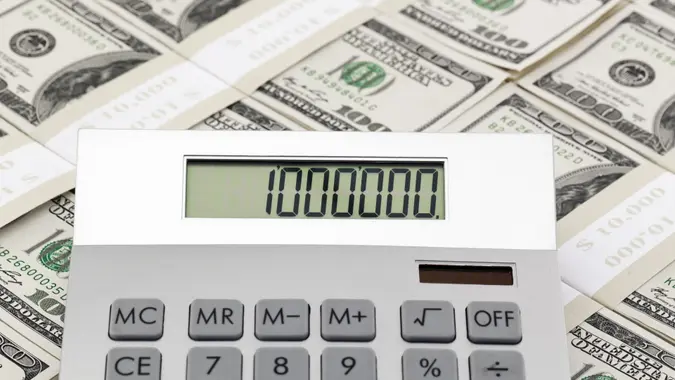Advertiser Disclosure
GOBankingRates works with many financial advertisers to showcase their products and services to our audiences. These brands compensate us to advertise their products in ads across our site. This compensation may impact how and where products appear on this site. We are not a comparison-tool and these offers do not represent all available deposit, investment, loan or credit products.
5 Simple Ways To Teach Kids How To Properly Manage Their Money in the Future
 Written by
Stacy Sare Cohen
Written by
Stacy Sare Cohen
 Edited by
Rebekah Evans
Edited by
Rebekah Evans

Commitment to Our Readers
GOBankingRates' editorial team is committed to bringing you unbiased reviews and information. We use data-driven methodologies to evaluate financial products and services - our reviews and ratings are not influenced by advertisers. You can read more about our editorial guidelines and our products and services review methodology.

20 YearsHelping You Live Richer

Reviewed by Experts

Trusted by Millions of Readers
Turn back the clock back to the time you were in high school. Did you learn about personal finance in the classroom, from your parents, or through trial and error? Check out these baffling statistics:
- 57% of adults are considered financially illiterate, according to MarketWatch.
- The U.S. has more than $1 trillion in credit card debt
- 28% of adults don’t have retirement savings, according to a GOBankingRates study
- 88% percent of adults believe financial education should be taught in schools.
This comes as no surprise as many high schools put too much focus on standardized tests and don’t base the curriculum on personal finance — improving credit scores, managing a budget, investing, and avoiding debt.
If your child’s school doesn’t teach financial literacy, here’s how you can show your kids how to manage their money in the future.
Teach Your Kids the Value of Money
Earning an allowance is a good starting point for kids to learn the value of money in exchange for doing work around the house. An allowance also teaches children to make choices that reward them when they take responsibility for completing chores. Kids are often more invested in making decisions about their own money rather than a parent’s.
Open a Savings Account
Take your kids to the bank to show them how their money can build interest. Open a savings account for them where they can deposit their money once a week. Explain how the bank rewards people for saving their money.
When your child gets older, you can open a Certificate of Deposit (CD), where your child can earn a fixed rate over a fixed term. CDs pay higher rates than standard savings accounts. Show them how their money grows for three months compared to three years.
How To Save Money With Coupons
Coupons can save people hundreds of dollars on one trip to the grocery store. Have your child cut out coupons you receive in the mail and take them with you to the store so they can see how much you saved shopping. Show them the deductions on the receipt.
This provides an opportunity to teach your children how discounts help keep more money in a bank account that can be used for a special purchase like a summer vacation or saved for a rainy day when they need to buy something.
Make Money Selling Goods and Services
You can teach your kids about commerce while they practice math calculations (addition, subtraction and percentages such as 10% off) by selling goods and services.
One example is to go through your child’s closet together and collect unused items for a garage sale. You can sell your child’s old toys, clothing and board games. Teach your child to price items and negotiate prices with customers that offer too little.
Other ways to sell goods and services could include:
- Setting up a lemonade stand in the summer
- Babysitting for neighbors
- Mowing the lawn
- Dog walking
After they count their earnings, suggest keeping 50% of their earnings as a reward for their hard work and putting the other half in their savings account.
Open a Custodial Account
Kids need to be 18 to open a brokerage account to invest in the stock market, but parents can open a custodial account on their behalf labeled UTMA or UGMA. This is a great opportunity for your kids to watch as their money appreciates over time.
Consider investing in a company that manufactures a product they own, such as Apple, if they have an iPhone or a toy company. Seeing their money grow can inspire them to invest as adults
Older kids can open up custodial accounts with more control designed for teens 13 to 17. They can manage the account and parents receive alerts about their transactions and activity.
Share This Article:




You May Also Like

I'm a Financial Advisor: 3 Types of Bills Millionaires Never Put on Autopay
December 29, 2025
4 min Read


Avoid the No. 1 Post-Layoff Mistake -- Plus Expert Tips To Negotiate Better
December 19, 2025
4 min Read


I'm a Self-Made Millionaire: How the Most Fun Side Gig I Ever Had Made My First Million
December 29, 2025
4 min Read


If Michael Jordan's Wealth Were Evenly Distributed Across America, How Much Money Would Every Person Get?
December 24, 2025
4 min Read




4 Financial Tasks I Stopped Paying Experts for After Discovering ChatGPT
December 26, 2025
4 min Read


2026's 10 Highest Paying, Fast-Growing Jobs That Don't Require a College Degree
December 24, 2025
4 min Read
Make your money work for you
Get the latest news on investing, money, and more with our free newsletter.
By subscribing, you agree to our Terms of Use and Privacy Policy. Unsubscribe at any time.


Thanks!
You're now subscribed to our newsletter.
Check your inbox for more details.



Sending you timely financial stories that you can bank on.
Sign up for our daily newsletter for the latest financial news and trending topics.
For our full Privacy Policy, click here.
Looks like you're using an adblocker
Please disable your adblocker to enjoy the optimal web experience and access the quality content you appreciate from GOBankingRates.
- AdBlock / uBlock / Brave
- Click the ad blocker extension icon to the right of the address bar
- Disable on this site
- Refresh the page
- Firefox / Edge / DuckDuckGo
- Click on the icon to the left of the address bar
- Disable Tracking Protection
- Refresh the page
- Ghostery
- Click the blue ghost icon to the right of the address bar
- Disable Ad-Blocking, Anti-Tracking, and Never-Consent
- Refresh the page





